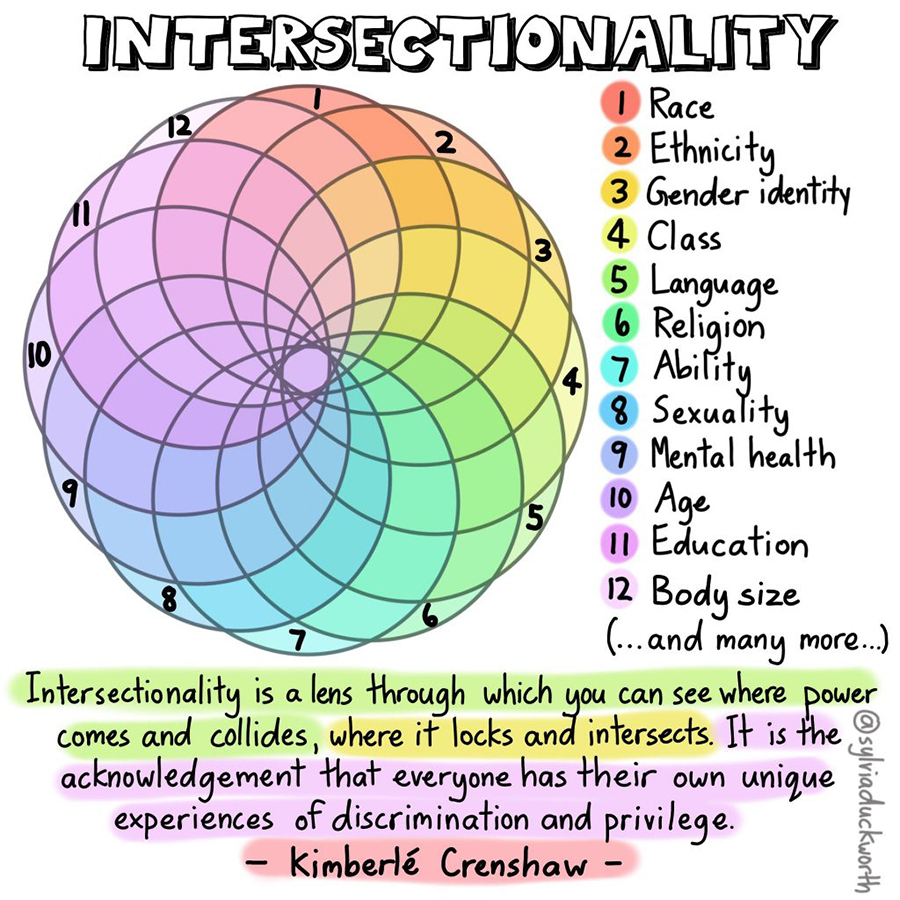Using an intersectional lens to fight health care inequities, discrimination

Defining intersectionality and why it’s important
Intersectionality is a popular buzzword these days, especially in the justice, equity, diversity, inclusion, and belonging realms. But how many people really know what the word means and why it’s important, especially to combat health care inequities?
The word intersectionality was first coined by law professor, social theorist, and American civil rights advocate Kimberlé Crenshaw in her 1989 paper, “Demarginalizing the Intersection of Race and Sex: A Black Feminist Critique of Antidiscrimination Doctrine, Feminist Theory, and Antiracist Politics.” Crenshaw used the word to describe how race, class, gender, and other individual characteristics “intersect” with one another and overlap, according to this informative Vox article.
But the roots of the word began in 1976 when five Black women from Missouri filed a class action Title VII suit alleging that their employer, General Motors, discriminated against Black women. The court ruled that the plaintiffs could not combine the claims of race and sex discrimination. Medium.com has an informative article about the case if you want to know more.
It’s now widely recognized – and Crenshaw pointed out in 1989 – that treating the plaintiffs of that case as solely women or solely Black ignored the specific challenges they faced as Black women, according to the Vox article.
Since Crenshaw first named and described intersectionality, the definition has expanded to include ways in which systems of inequality related to gender and gender identity, race, ethnicity, sexual orientation, disability, class, and other forms of discrimination intersect to create unique challenges.
Intersectionality provides insight into how multiple dimensions of one’s identity and systems of inequality interact with one another and create very distinct experiences and outcomes. Intersectionality is crucial in addressing health care inequities. Using an intersectional lens allows us to identify patterns, drivers, and intervention points that we would miss if we were just focusing on one of these systems or identities.
We should never assume each dimension of identity is the same. Many different factors influence each of our lives, from our upbringing to social drivers, inequities, environment, and much more. For example, assuming every member of the LGBTQIA+ community identifies the same way or has the same lived experiences can create bias. Assuming everyone who speaks Spanish the same way while ignoring their heritage and country of origin can drive microaggressions.
To combat this type of discrimination, explore your own biases and assumptions. Acknowledge where the roots lie. Live in others’ shoes just for a moment. Be empathetic. Self-awareness and reflection are vital to create important and profound changes.
Consider this wheel created by renowned educator and visual artist Sylvia Duckworth that illustrates how social identities intersect with one another and are wrapped in systems of power. Use it to think about your own identities and how your lived experiences have shaped you into who you are. How do your various identities intersect with one another? What has your life experience been like with the various identities that make you who you are?

The approach to intersectionality ensures that as we fight for justice, no person is left behind. Working together, inclusive of our differences, is how we combat all forms of discrimination and injustice.
For more information, please watch:
Thank you,

Allison LaRussa, B.A, CPS, RYT (she/her)
AVP, �ʼһ��� Humanities, Trauma-Informed Sanctuary Frameworks,
and Justice, Equity, Diversity, Inclusion, and Belonging
The Wright Centers for Community �ʼһ��� and �ʼһ��� Medical Education
